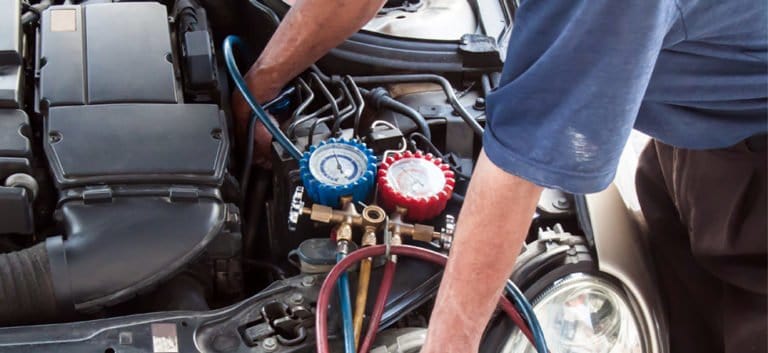Affiliate Disclosure: Some of the links in this post are affiliate links. As an Amazon Associate, we earn from qualifying purchases. Read more in our affiliate policy.
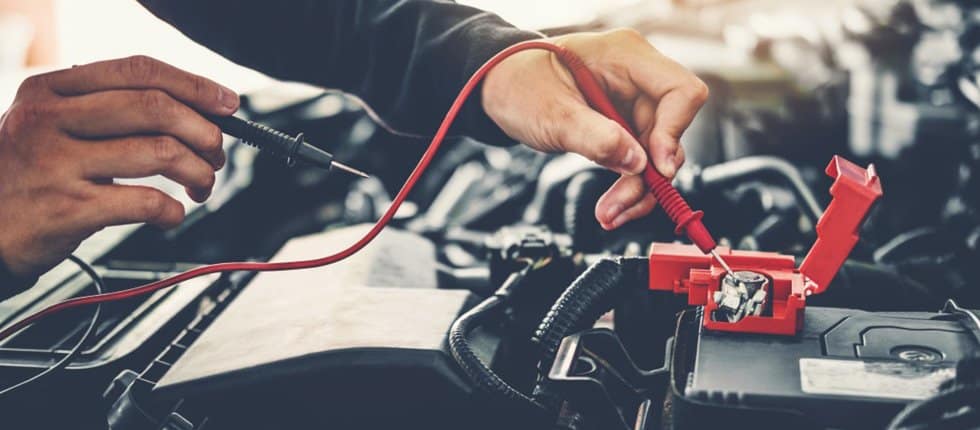
How Many Volts Is a Car Battery? The Normal Car Battery Voltage Range Explained
Some of you, our dear garagechief.com readers, prompted us to ask how many volts is a car battery. To answer your request, in today’s post, we’re going to discuss exactly this – the normal car battery voltage range.
As you know, the battery is the heart of any automotive vehicle.
It houses the power that the engine needs at startup and it also provides the power needed by the car’s lights and accessories.
When you turn the ignition on, a signal is sent to the battery which makes it convert chemical energy into electrical energy. The generated electrical power is then sent to the starter then to the crank engine.
A low voltage battery would not give you this effect, therefore it is important to know how many volts there should be in a car battery, or how many volts are needed to start a car.
How Many Volts is a Car Battery? The Voltage Range Explained
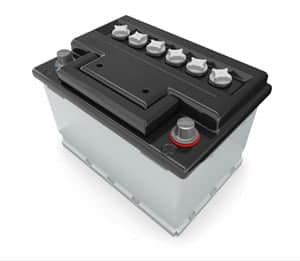
So there may not be a one-fit answer to how many volts a car battery is.
The long and short of it is that a car battery that is fully charged should ideally be at 12.6 volts up.
If the engine is running, the reading should show 13.7 to 14.7 volts.
A standard automotive (a car that is non-hybrid and not all electric) battery has 6 cells with 2.1 volts each (thus the 12.6 volts) at full charge.
A battery can be considered charged at 12.4 volts or higher. Anything below 12.4 volts means that the battery is discharged.
That’s how many volts are in a car battery for an average car. But what about other vehicle types?
Average Car Battery Voltage – Other Vehicle Types
Until the 1950s, older cars with small engines used 6-volt car batteries. When bigger engines with higher compression ratios came into the picture, the switch from 6 to 12 volts happened.
Large vehicles today may use 24 or 36-volt systems which are accomplished by using two or three 12-volt batteries.
Military use vehicles may be designed to run on and use 24-volt military-spec batteries (6T).
Testing The Normal Car Battery Voltage
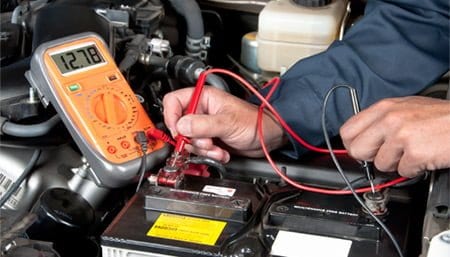
You can record the readings for future use and comparison.
If you don’t have a voltmeter, try the following.
Start the vehicle and turn the headlights on.
If the light is dim at idle, or if the headlights become brighter when you rev the engine up, or the interior lights are gradually dimming as the car runs, it is most likely the alternator that’s causing the issue.
If you’re not experiencing any of these signs the car battery’s voltage may be at fault.
A Car’s Cranking Power
Where is a voltage, there could also be current. As current is an effect of the car’s battery voltage and works hand-in-hand with it to start your car, it is important that we discuss a car’s cranking power.
Cold Cranking Amps (CCA) is a widely used benchmark when gauging cranking power in North America and Europe where it’s colder. It refers to the number of amps a 12-volt battery can provide at 0°F for 30 seconds while it keeps a voltage of at least 7.2 volts.
For example, a 250 CCA battery will give 250 amps for 30 seconds without the voltage dropping to 7.2 volts.
In layman’s’ terms it is the power that a battery can provide to start a cold engine.
So how much CCA do you need to start your car?
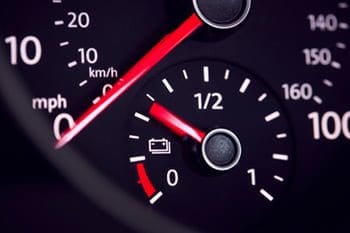
Understanding the conditions that the vehicle is going to be working under is important.
The colder the temperature, the more cold cranking power your car requires.
You can go for the recommended cold-cranking amps set by the manufacturer but you can always bump it up if you live in an area that gets really cold.
How Long Can a Car Battery Last?
You may come across an amp hour (Ah) rating when checking out car batteries. This tells you how long the battery will last if you don’t recharge the battery.
You would probably want to check the manufacturer’s fine print as they may not use the same hour rating when calculating the Ah rating.
For demonstration purposes, let’s say the manufacturer uses a 20-hour rate. A 200 Ah car battery can endure a 10-amp draw for almost 20 hours (200 Ah / 20 hours = 10 amps) before it completely discharges. If you step up your draw to 50 amps, it’ll last 4 hours (200 Ah / 50 amps = 4 hours.)
Batteries State of Charge for Different Battery Sizes
| to-center | State of Charge | V open circuit | V open circuit | V open circuit | V open circuit | specific gravity |
| item-title | 6 Volt Battery | 12 Volt Battery | 24 Volt Bank | 48 Volt Bank | per cell | |
| 100% | 6.37 | 12.73 | 25.46 | 50.92 | 1.277 | |
| 90% | 6.31 | 12.62 | 25.24 | 50.48 | 1.258 | |
| 80% | 6.25 | 12.50 | 25.00 | 50.00 | 1.238 | |
| 70% | 6.19 | 12.37 | 24.74 | 49.48 | 1.217 | |
| 60% | 6.12 | 12.24 | 24.48 | 48.96 | 1.195 | |
| 50% | 6.05 | 12.10 | 24.20 | 48.40 | 1.172 | |
| 40% | 5.98 | 11.96 | 23.92 | 47.84 | 1.148 | |
| 30% | 5.91 | 11.81 | 23.62 | 47.24 | 1.124 | |
| 20% | 5.83 | 11.66 | 23.32 | 46.64 | 1.098 | |
| 10% | 5.75 | 11.51 | 23.02 | 46.04 | 1.073 |
12V Car Batteries State of Charge for Different Battery Types
| item-title | State of Charge | Sealed or Flooded Lead Acid battery voltage | Gel battery voltage | AGM battery voltage |
| 100% | 12.70+ | 12.85+ | 12.80+ | |
| 75% | 12.40 | 12.65 | 12.60 | |
| 50% | 12.20 | 12.35 | 12.30 | |
| 25% | 12.00 | 12.00 | 12.00 | |
| 0% | 11.80 | 11.80 | 11.80 |
How Many Amps to Start a Car?
And how many amps is needed to start a car? Depending on the size, voltage, and temperature of the engine, it can take between 400 to 1000 amps to start a car. Smaller cars could probably get by with 300 amps.
A 12-volt car battery usually has a 48 Ah capacity and a basic battery charger will need about 2 amperes for 24 hours to provide 48 amps to a 12-volt battery with a 48 Ah rating.
Knowing the right battery type for your car
-
Starting, Lighting, and Ignition (SLI)
These are lead-acid batteries and they are widely used by gasoline and diesel engines. As the name suggests, this battery helps start your car and gives power to the ignition, lights, and other car accessories by providing short bursts of energy.
SLIs don’t take that much time to run the battery down and charge back up.
-
Lithium-Ion (Li-ion)
Hybrid and electric cars typically use Lithium-Ion (Li-ion) batteries. They are known to be capable of storing more energy without being as heavy as the traditional lead-acid batteries.
They are infamous, however, for not lasting as long, averaging only at a 3-year lifespan.
-
Deep Cycle
A deep cycle battery is designed to give a constant current over an extended period of time which makes them suitable for small recreational vehicles such as golf carts and also for marine vehicles.
-
Wet Cell
Wet cell batteries are cheaper than most options. It would be common to find wet cell batteries in aviation applications.
Additional care would be needed for these batteries though. This battery got its name because it creates power from a liquid electrolyte solution and a pair of electrodes. Poor maintenance of these batteries could cause acid spills and if the battery vent plugs are not tightly closed, acid evaporation can happen.
-
Valve-Regulated Lead-Acid (VRLA)
They are meant to be low maintenance and do not need regular addition of water to the cells. The batteries are also sealed to prevent spills.
Due to their design, repair or maintenance work cannot be performed on them and they would just have to be replaced if they begin to refuse to do what they’re supposed to do.
How Many Volts in a Car Battery – The Conclusion
So there you go, we hope we explained in sufficient detail how many volts is a car battery. They key take away here is that, on average, a car battery can last between two to five years.
Proper battery care must be exercised to not only make them last and worth every penny but also to guard your safety.
A bad battery could cause bad to serious problems like having dim headlights (a possible safety hazard), slow crank, needing to step on the gas to get the car to start, or backfiring.
Ensuring that every single part, nut, and a bolt of your car is in tip-top condition will let you have safe and enjoyable trips that are not to your mechanic.
Drive safe!
Disclaimers
All product names, logos, and brands are property of their respective owners. All company, product and service names used in this website are for identification purposes only. Use of these names, logos, and brands does not imply endorsement.
It is our policy to make every effort to respect the copyrights of outside parties. If you believe that your copyright has been misused, please provide us with a message stating your position and we will endeavor to correct any misuse immediately.
Some of the links in this post are affiliate links. As an Amazon Associate, we earn from qualifying purchases. This means if you click on the link and purchase the item, we may receive an affiliate commission, at no extra cost to you. This helps us keep this website alive. Read more in our affiliate policy.


